Click here to print
Saving Albania’s Film Legacy
posted December 5, 2012
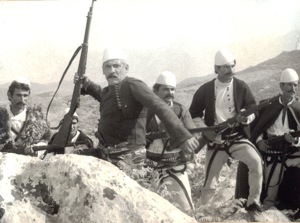
A still from “Nentori i Dyte,” from 1982, the first film restored by the Albanian Cinema Project and its friends.
Few filmgoers know much about Albanian cinema. That’s a safe bet.
Most might be surprised to learn the country had one. After all, from 1944 until his death in 1985, the dictator Enver Hoxha imposed a reign of oppression. In his mix of delusion, paranoia, and calculation, he ordered Albanians to stave off a concocted military threat by constructing defensive bunkers throughout the country. Still, 27 years after his death, 750,000 of them litter a country of only three million people.
Over the last six months, Regina Longo, who teaches in the department of film and digital media at the University of California at Santa Cruz, has served without pay as the director of the Albanian Cinema Project, which aims to preserve, restore, and promote the country’s film heritage.
The project’s aim is to bring awareness, attention, and assistance to the Arkivi Qendror Shteteror I Filmit (Albanian Film Archive), whose current home is riddled with mold, to the growing detriment of its holdings.
The Albanian Cinema Project is at the forefront of a campaign to relocate the collections of the archives to a new, mold-free facility. (How about a bunker or two? See below.) Longo and her colleagues have advanced this goal by developing partnerships with governmental and intergovernmental agencies, and with colleagues worldwide among filmmakers, film archivists, and film scholars.

“When I first got involved,” says Longo, “I thought it would amount just to providing some triage over the phone and via email and Skype with the archivists who were working there, to see if we could come up with short-term solutions to a much longer-range problem.” The task would, she initially imagined, draw readily and simply from her expertise in archival theory and practice. She also specializes in international documentary film history and Italian film and cultural studies. After studying film archiving at the George Eastman House, she worked as a film and media archivist. She spent six years at the The Steven Spielberg Film and Video Archive of the US Holocaust Memorial Museum in Washington, DC, restoring and reconstructing the outtakes of Claude Lanzmann’s Shoah. While at the museum she also shepherded the acquisition and preservation of the “Julien Bryan Collection.”
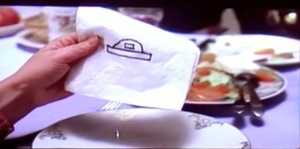
She was drawn into the Albanian archives’ problem by a friend, Thomas Logoreci, an Albanian-American filmmaker who settled in Albanian after marrying filmmaker Iris Elezi and teaches at the Marubi Academy in Tirana, Albania’s first film school, which is located on the grounds of the old Kinostudio right next to the archives. Its founder and still director is Kujtim Cashku, a much-honored filmmaker who also directs OraFilm, Albania’s first film production company.
Logoreci has worked with the AQSHF to present screenings and as part of the DokuFest programming team. While visiting San Francisco, he contacted Longo to ask for her advice on managing the problems of the Central State Film Archive. She learned that AQSHF staff have done all they can within the limits of scarce government funding. As a result, a staff that formerly numbered 20 now has shrunk to 12.
Initially, says Longo, “we were thinking it was just a mold problem.” That was, itself, no minor issue. Because the archives’ building was thoroughly riddled with the growth, the collection needed constant cleaning. Worse, says Longo, the staff were cleaning and recleaning the same reels of film, working away with rubbing alcohol and cloths. “That was rather pointless, and they were not able to do much of the other work at the archive,” she says.
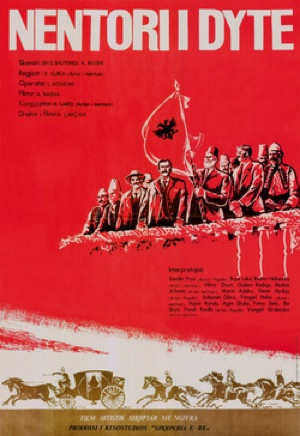
Original film poster, restored by AQSHF
She volunteered to provide the staff with consultation at a distance and to organize to have some supplies sent to them. Then, in July 2012 she was able to visit the archive, and began collaborating with the staff. The project and the team grew quickly and now has launched its first restoration project in Tirana, a digital restoration of Nentori I Dyte (“The Second November”). Viktor Gjika (1937-2009) directed the 1982 feature film, which the social realist author Dhimiter Shuteriqi wrote. Made with Hoxha’s permission, three years before he died, it depicted the country’s 1912 struggle for independence from the Ottoman empire, a subject dear to the heart of the ultra-nationalist dictator.
She was struck not just by the seriousness of the mold problem, but also by how intently staff have done what they can. “All the cans are brand spanking shiny and new, and everything is very well organized. It’s all in canisters that hold entire feature films and look almost like barrels, like metal ash cans, with 1,000-foot 35mm film reels. They’ll hold 7 to 10 reels that make up the one film; when you open up each of those cans, that’s when you can see the mold growing on the film.
“Imagine trying to maintain over 6,500 film titles – many, many, many reels of film, almost all 35mm – in 100-degree temperatures in the summer, with a leaky roof, and a leaky foundation, in a really very poorly constructed although very new building.” The archive was originally housed next door at the Kino film studio – Kinostudio Shqipëria e Re – which Hoxha set up in 1952, with Soviet support. Now it is home to the Albanian National Center of Cinematography, the Marubi Academy of Film and Multimedia, and several television studios.
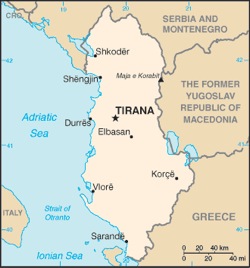
CIA Fact Book
Just before the Communist regime crumbled, and a new political group took over in 1991, the national government broke ground for a new building, which was completed in 1997. At that newer home of the archives, some staff were older women who had worked at the archive in its Kino studios location. Longo says they had applicable skills, but most higher ups were politically appointed film-industry figures who, while well intentioned, did not have archiving or management experience.
When Longo visited the facility, she was greeted by an odor of vinegar that archivists know well as a sign of deteriorating film stock. Electricity rarely ran in the building and certainly not in the vaults. “They were opening and closing the vault doors to try to get air circulation, but what they actually ended up doing was exacerbating the problem,” she says.
The facility has two handsome French chilling units that the East German film archive donated to them in 1985. But one is broken, and both are old and outmoded and no one is available domestically to service them. Says Longo: “The only place there was a technician was in Greece, who covered that whole region, so somebody would be in Albania once every two or three months.” The chilling units should run on a constant supply of fresh water, but Longo found that one stagnant tank of used water had been circulating since the autumn of 2011.
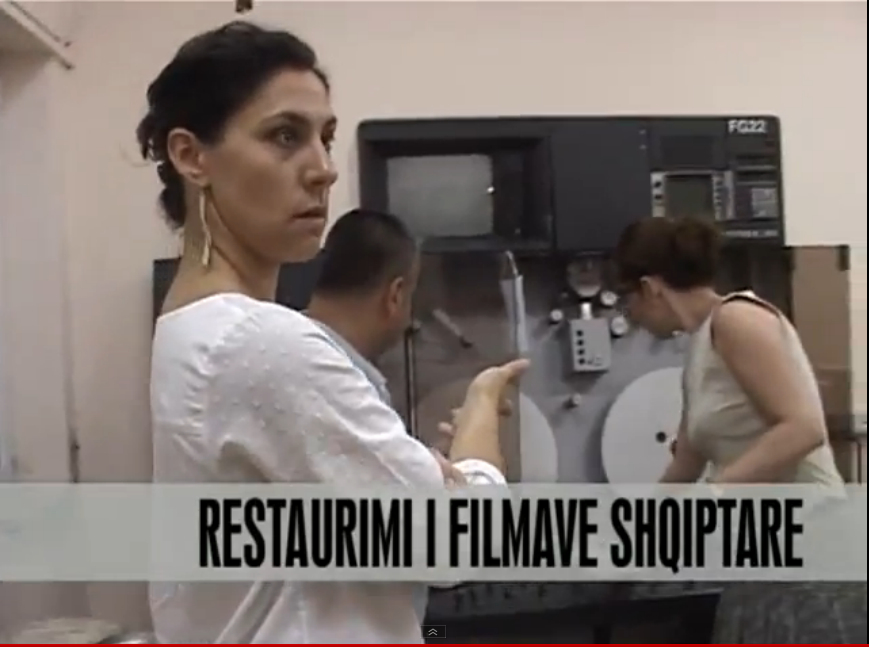
Regina Longo in the archive, a still from an Albanian television spot (click on image to view in YouTube, if your Albanian is up to it).
In the facility’s non-operating theater, built in 2000, Longo found the projection room disused for over a year for lack of money for bulbs. “When we got there, there was still a roll of film loaded,” she recalls. “It was growing mold all over, so it’s obvious the mold is even in the air in the building.”
Any archivist would shudder at all that, and in Longo’s voice it registers that she did, too. “Looking at the conditions there,” she says, “I realized there wasn’t any point giving them supplies; what they really needed to do was get out of that building. They were breathing in these things all the time. Except that, half the time they don’t have Internet and they don’t have electricity, so they work from home, which when you’re trying to manage archives and you need to do hands-on work in the archives…”
With all that, says Longo, she was moved by the impending eradication of Albanian’s film history. “To me, the idea of an entire national cinema being absent from film-history books and film-history courses was and is inexcusable,” says the film historian in her. Only then, she says, can she and fellow scholars show how Albanian cinema intersects with the film history of the rest of Europe and with China and other countries. “Albanians,” she says, “want their film history to be known outside Albania, but it has taken time to organize other aspects of the country and government post-1990s, to allow Albanians the time to shift from rebuilding a country after regime change to safeguarding and preserving the country’s cultural history.”
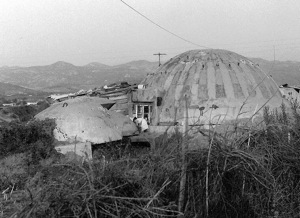
A bunker big enough to become a home
It seems only appropriate that a remnant of Hoxha rule may help to save the nation’s cinema inheritance. In typical dictator style, he had a massive bunker built for himself and other senior figures of his regime. And, says Longo, “there is now a big push among younger Albanian architects to refit the structures for a more useful purpose.” Tirana has several thousand. “Some are small and falling down, but some are huge and in decent shape,” she says. In the late 1990s, protesters staged a huge public standoff with the authorities, prompting the military to renovate some of the large inner-city bunkers.
After her visit in July 2012, Longo wrote a report for Aldo Bumci, Albanian Minister of Culture, at his request, to assure him that figures in the Albanian film and film-archiving communities are determined to make the restoration and preservation project work. She suggested that Albania could appropriately treat film just as it is treating art, literature, and architecture in planned museum for Soviet-era culture because “cinema was such a prominent part of the apparatus,” she says.
Preparation of one large bunker has begun as a home for a museum of Communist-era culture. Longo and her colleagues have proposed that the film archive be granted a similar facility, and the Minister of Culture has offered a choice of three bunkers that are in good condition to at least temporarily store the films, after cleaning, and then to raise money to repurpose one of the bunkers into a film archive, with offices, and auditorium.
Even beyond securing such a facility, the project’s personnel and supporters are well aware that solid funding – from the private sector and foundations as well as the Albanian government – will be needed, too. At the moment, the whole annual budget for the film archives – for everything, from staffing to repairs – is less than what it costs to restore one feature film.
Albanian Cinema: A Potted History
In their report, Longo and her colleagues nominated five titles whose preservation was crucial in recovering the nation’s film history. Indeed, Albania had a relatively active film industry before 1950. After that, foreign influence increased. Until the 1990s, however, few Albanian films were translated or subtitled and shown abroad.
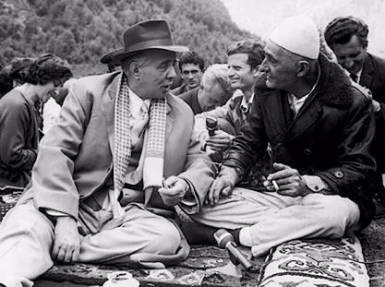
Longtime Albanian dictator Enver Hoxha demonstrates his common touch with the peasanty
In 1939, fascist Italy invaded Albania and established a puppet government. Before and during World War II, Hoxha worked his way up in Communist circles. Soviet intrusion in Albania was minimal. It was local partisans who worked to drive out the Italians, aided at times by the British intelligence service. Late in 1943, Hoxha was appointed interim Prime Minister and leader of disparate anti-fascist forces that in 1944 liberated the country.
From 1944 until his death in 1985, Hoxha held the country under Communist sway of his own idiosyncratic form. He at times professed staunch Stalinist Marxist-Leninism and at others Maoism. Early in his rule, he broke with Yugoslavia, which like Albania sought to rid itself of fascist dominance. Then he broke with the Soviet Union, which he considered insufficiently Marxist-Leninist. Among his motivations in revising his own adherences was his belief that all the Eastern European Communist states had acceded to revisionism: pale approximations of Hoxha’s Communist ideal.
His way of enacting that true belief was to introduce land reform and industry nationalization, which soon prompted Western intelligence agents to try to undermine him. His erratic rule, and its odd expression – the bunkers, the isolationist stance – contributed to Western suspicions. So did his Stalinism, to which he long clung despite revelations about its grim realities.
As histories of Albanian cinema on the Project’s website and an online article by Thomas Logoreci relate, few elements of foreign film pierced Hoxha’s strategic defense initiative to influence Albania’s fledgling industry. Unsurprisingly, political turgidity was not conducive to art.
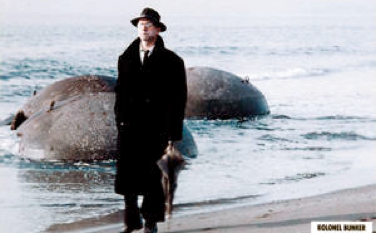
The feature film “Kolonel Bunker,” which is about Colonel Muro Neto, the man Hoxha charged with constructing the bunkers throughout the country, was the first Albanian-French-Polish coproduction. It was released throughout Albania in 1996 and screened at festivals in Britain, the United States, Spain, Greece, and India
Since the death of Hoxha and the ensuing fall of Communism, younger Albanians have suspected the country’s legacy of state-sponsored film but have remained largely unfamiliar with its unideological moments. Those date to early in the history of filmmaking and exhibition. In 1912, three months before Albania declared independence from Turkey, an Austrian film-distribution company built the nation’s first cinema in Shkodra, in Albania’s north. It lasted only two years, but in 1920 theaters opened in Berat, Shkodra, Vlore, and the capital, Tirana. By the Italian invasion in 1939, a film industry had begun with uncertain steps, not aided by German invasion in 1943, and the ascendance of Communism soon after. Hoxha had learned from the Soviet Union and Yugoslavia that film could serve well in shaping public opinion, so had a documentary made: The Commander Visits Central and Southern Albania.
In 1952, the Soviet-built Kinostudio opened in Tirana, and film students went to Czechoslovakia and the Soviet Union. The apprentices included future directors Dhimiter Anagnosi, Piro Milkani, and Viktor Gjika. (Gjika is among Albania’s most well-known filmmakers, and ran the state film studios for a time.)

Arta Dobroshi, in Syri magjik (Magic Eye), a 2005 feature film about a cameraman who possesses explosive footage of the killing of a girl. She later starred in the Dardenne brothers’ Le Silence de Lorna (“The Silence of Lorna,” 2008)
In 1953, a co-production with the Soviet Union, Scanderbeg, appeared. Directed by a Russian, Sergei Yutkevich, it featured Albanian actors. The Project’s history page relates that it was an epic about the 14th century warrior who opposed Turkish occupation, featured “several astonishing battle sequences,” and won the International Prize at the 1954 Cannes film festival. In 1958, the release of the first entirely homegrown production, Kristaq Dhamo’s Tana, announced a flowering of Albanian film: Hysen Hakani’s Debatik (1961), Toke Jone (“Our Land,” 1964), and Ngadhnjim Mbi Vdekjen (“Triumph Over Death).
With Albania’s shift from Soviet to China patronage, independent film contracted again, but film jobs were aplenty for propagandists, and some managed stylistic innovations. But only a few filmmakers managed to skirt regime censorship, most notably Muharrem Fejzo and Fehmi Hoshafi’s comedy Kapedani (“Captain,” 1972), Anagnosti’s Lulekueqet Mbi Mure (“Red Poppies on the Wall,” 1976) and Rikard Ljarja’s Sketerre 43 (“Hell 43,”1980). Still, despite its isolation, Albania produced an average of 13 movies a year between 1975 and 1990, when borders reopened, with impressive cinema attendance: 20 million seats sold in 450 indoor and outdoor theaters, annually; national attendance averaged 10 films per year. The absence of TV (how did they manage?) contributed to that. From Tana (1958) to 1995, Albania produced 270 feature films, 700 documentaries, and 150 animated films. (Samples of many Albanian films are online.)
As isolated as he made Albania, Hoxha indulged for himself a fascination with French culture, including film. As a result, a 1980s project led to some poor French dubs of Albanian films showing on French television.
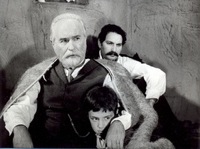
In Nentori I Dyte, the highly regarded theater and screen actor Alexsander Prosi played the revered patriot Qemal Bey Vlora (1844-1919), who led Albania’s struggle for independence. The film’s director, Viktor Gijka (1937-2009), came to prominence after working in the Soviet Union. “Nentori I Dyte premiered” on 27 November 1982, one day before the 70th anniversary of independence. Colorlab Film Corp., based in New York and Rockville, Maryland, collaborated with the Albanian Film Archive and the Albanian National Film Center to restore and exhibit the film in a new, color, 35mm print with a re-mastered soundtrack and English subtitles. The restoration premiered at the 13th Festival of Albanian Film on 3 November 2012, the centenary of independence, and is now traveling internationally to raise awareness of Albanian cinema and to publicize the Albanian Cinema Project’s efforts
“A fortunate outcome of the closed regime of Enver Hoxha,” note Longo and her colleagues, “is that the film archives managed to keep track of nearly all of the features, shorts, documentaries, newsreels, and animated films produced in Albania since 1952. The archives also holds film stills, posters, press books, screenplays, continuity scripts, musical scores, and many other production elements that are often lost in more dispersed collections.”
And, at least among film history oriented Albanians, “it’s really important to the Albanians that their films don’t leave Albania,” Longo says.
Those fortunate aspects of a troubled legacy, alone, encourage her and her colleagues in their project and efforts to secure proper storage, she adds. Also among the priorities of the Albanian Cinema Project is to familiarize international audiences to the nation’s films, ideology-freighted and not. But that perturbs many Albanian intellectuals of the post-1991 generation; Longo says they commonly ask: “‘What are you doing; this is complete ideological bunk?’ They’d prefer to look at foreign cinema, yet there really aren’t that many venues that screen film in the entire country.” Even Tirana has only a few functioning theaters for a population that has grown from 200,000 in 1991 to approaching one million, now, of the country’s population of 3.2 million.
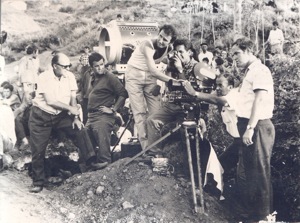
Viktor Gjika directing “Nentori I Dyte” (The Second November) in 1982.
Several talented filmmakers have emerged to give voice to the Albanian experience, among them Fatmir Koci (Tirana Year Zero, Nekrologji), Gjergj Xhuvani (Slogans, Dear Enemy) and Bujar Alimani (Gas, Amnestia). Particularly noteworthy, for film archivists, is Koci’s In the Land of the Eagles, from 2007. Koci constructed it entirely from archival selects going back as far as 1914.
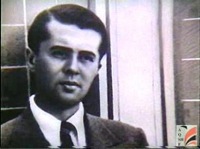
Viktor Gjika early in his career
Thanks to the Project and its supporters, one film has now been restored, and presentation of it are ongoing. In this year of the 100th anniversary of Albanian independence, Colorlab Film Corp. has worked with the Albanian Film Archive and the Albanian National Film Center to restore Nentori I Dyte (The Second November). A digital restoration of the film, with a re-mastered soundtrack and English language subtitles, premiered at the 13th Festival of Albanian Film on 3 November 2012. The title was chosen at the recommendation of a former archives director, Artan Minarolli, a filmmaker who now heads Albania’s National Center for Cinematography, who hoped a digital version would be complete in time for the November festival, which it was. The Second November is set to travel internationally, with a North American premiere on 27 March 2013 at New York University, a New England premiere on 28 March 2013 at Wesleyan University Cinema Archives, and a Detroit premiere sometime in April. A color 35mm print is high on the Project’s list of priorities, but for now it awaits the raising of $35,000 in funding. Stay tuned for the Kickstarter project.
Already, however, the restoration provides a far more satisfying film experience than poor online copies, but until now most film fans have had to content themselves with viewing Albanian films in that way.
The Albanian Cinema Project has partnered with the San Francisco Media Archive. As a result, donations in the United States, which can be made through the project’s donation page, are tax deductible. Donations of services also are welcome.
– Peter Monaghan
Printed from Moving Image Archive News: http://www.movingimagearchivenews.org
URL to article: http://www.movingimagearchivenews.org/saving-albanias-film-legacy/
Click here to print